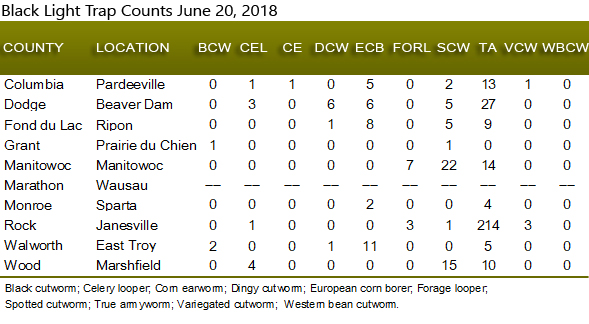
 |
|
|
Corn
Volume 63 Number 8 Date 06/21/2018 CORN ROOTWORM - Egg hatch has been underway since early June and should peak across much of the state before the end of the month. Corn root pruning assessments can begin about a week after peak egg hatch, or by early to mid-July. Continuous corn and areas with Bt performance issues should be the highest priority for inspection and root ratings. WESTERN BEAN CUTWORM - Moth emergence began this week from La Crosse east to Fond du Lac County. Based on projected degree-day accumulations, 25% emergence of the moth population can be expected from July 8-14 in southern Wisconsin and during the week of July 15-21 in the central counties. A new model developed by UNL and UMN entomologists shows that the optimal method for predicting the western bean cutworm flight uses simple degree-day calculations beginning March 1, with a 38°F lower threshold and a 75°F upper threshold. The new cumulative flight model indicates that 25% of moth flight should be complete when 2,577 degree-days (Fahrenheit) have accumulated. Consultants and field scouts are advised to begin inspecting pre-tassel-stage corn to estimate egg density around 25% moth emergence. EUROPEAN CORN BORER - Surveys this week found minor infestations affecting no more than 10% of plants in a few V9-V10 fields. Moths and first-instar larvae were the development stages observed. The larvae appeared to have hatched on June 16 or 17. Chemical and biological insecticides targeting first-generation ECB are only effective for about a week after egg hatch, and must be applied in the next few days in fields where small larvae are emerging. The treatment window is expected to close by June 24 near La Crosse, June 28 at Madison, and around July 4 near Appleton and Hancock. TRUE ARMYWORM - Non-economic larval infestations affecting 1-4% of corn plants are common, with about 20% of fields surveyed in the last week showing at least a few plants with armyworm leaf-edge feeding damage and/or larvae. Increased vigilance is recommended since black light traps are registering significant flights (214 moths at Janesville from June 14-20) and because field conditions remain very favorable for armyworm problems. STALK BORER - Larval infestations seldom exceed 5% in most fields. This perimeter pest migrates from perennial grasses and broadleaf weed hosts in June and infests mainly the first 4-6 rows of corn. Significant damage is unlikely once plants have developed past the V7-V8 stages. -- Krista Hamilton, DATCP Entomologist 





|
|
|